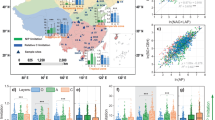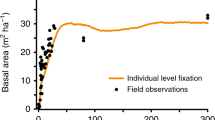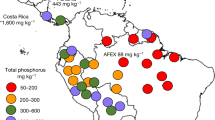Abstract
Nitrogen fixation, the biological conversion of di-nitrogen to plant-available ammonium, is the primary natural input of nitrogen to ecosystems1, and influences plant growth and carbon exchange at local to global scales2,3,4,5,6. The role of this process in tropical forests is of particular concern, as these ecosystems harbour abundant nitrogen-fixing organisms1,4 and represent one third of terrestrial primary production4,7,8. Here we show that the micronutrient molybdenum, a cofactor in the nitrogen-fixing enzyme nitrogenase, limits nitrogen fixation by free-living heterotrophic bacteria in soils of lowland Panamanian forests. We measured the fixation response to long-term nutrient manipulations in intact forests, and to short-term manipulations in soil microcosms. Nitrogen fixation increased sharply in treatments of molybdenum alone, in micronutrient treatments that included molybdenum by design and in treatments with commercial phosphorus fertilizer, in which molybdenum was a ‘hidden’ contaminant. Fixation did not respond to additions of phosphorus that were not contaminated by molybdenum. Our findings show that molybdenum alone can limit asymbiotic nitrogen fixation in tropical forests and raise new questions about the role of molybdenum and phosphorus in the tropical nitrogen cycle. We suggest that molybdenum limitation may be common in highly weathered acidic soils, and may constrain the ability of some forests to acquire new nitrogen in response to CO2 fertilization9.
This is a preview of subscription content, access via your institution
Access options
Subscribe to this journal
Receive 12 print issues and online access
$259.00 per year
only $21.58 per issue
Buy this article
- Purchase on Springer Link
- Instant access to full article PDF
Prices may be subject to local taxes which are calculated during checkout


Similar content being viewed by others
References
Galloway, J. N. et al. Nitrogen cycles: Past, present, and future. Biogeochemistry 70, 153–226 (2004).
Mahaffey, C., Michaels, A. F. & Capone, D. G. The conundrum of marine N2 fixation. Am. J. Sci. 305, 546–595 (2005).
Vitousek, P. M. et al. Towards an ecological understanding of biological nitrogen fixation. Biogeochemistry 57, 1–45 (2002).
Cleveland, C. C. et al. Global patterns of terrestrial biological nitrogen (N2) fixation in natural ecosystems. Glob. Biogeochem. Cycles 13, 623–645 (1999).
Reich, P. B., Hungate, B. A. & Luo, Y. Q. Carbon-nitrogen interactions in terrestrial ecosystems in response to rising atmospheric carbon dioxide. Annu. Rev. Ecol. Evol. Syst. 37, 611–636 (2006).
Gutschick, V. P. Evolved strategies in nitrogen acquisition by plants. Am. Nat. 118, 607–637 (1981).
Field, C. B., Behrenfeld, M. J., Randerson, J. T. & Falkowski, P. Primary production of the biosphere: Integrating terrestrial and oceanic components. Science 281, 237–240 (1998).
Clark, D. A. Detecting tropical forests’ responses to global climatic and atmospheric change: Current challenges and a way forward. Biotropica 39, 4–19 (2007).
Hungate, B. A. et al. CO2 elicits long-term decline in nitrogen fixation. Science 304, 1291–1291 (2004).
Wang, Y. P., Houlton, B. Z. & Field, C. B. A model of biogeochemical cycles of carbon, nitrogen, and phosphorus including symbiotic nitrogen fixation and phosphatase production. Glob. Biogeochem. Cycles 21, 10.1029/2006GB002797 (2007).
Crews, T. E., Farrington, H. & Vitousek, P. M. Changes in asymbiotic, heterotrophic nitrogen fixation on leaf litter of Metrosideros polymorpha with long-term ecosystem development in Hawaii. Ecosystems 3, 386–395 (2000).
Gupta, U. C. Molybdenum in Agriculture (Cambridge Univ. Press, 1997).
Williams, J. H. The effect of molybdenum reclaimed Welsh upland pastures. Plant Soil 4, 327–340 (1956).
Silvester, W. B. Molybdenum limitation of asymbiotic nitrogen-fixation in forests of Pacific Northwest America. Soil Biol. Biochem. 21, 283–289 (1989).
Pasricha, N. S., Nayyar, V. K. & Singh, R. in Molybdenum in Agriculture (ed. Gupta, U. C.) 245–270 (Cambridge Univ. Press, 1997).
Bellenger, J. P., Wichard, T., Kutska, A. B. & Kraepiel, A. M. L. Uptake of molybdenum and vanadium by a nitrogen-fixing soil bacterium using siderophores. Nature Geosci. 1, 243–246 (2008).
Cavalier, J. Fine root biomass and soil properties in a semi-deciduous and a lower montane rain forest in Panama. Plant Soil 142, 187–201 (1992).
Baillie, I., Elsenbeer, H., Barthold, F., Grimm, R. & Stallard, R. F. Semi-Detailed Soil Survey of Barro Colorado Island, Panama (Smithsonian Tropical Research Institute, 2007).
FAO-UNESCO. Soil Map of the World (Food and Agriculture Organization of the United Nations, 1990).
Hardy, R. W. F., Holsten, R. D., Jackson, E. K. & Burns, R. C. Acetylene–ethylene assay for N2 fixation—laboratory and field evaluation. Plant Phys. 43, 1185–1207 (1968).
Anderson, M. D., Ruess, R. W., Uliassi, D. D. & Mitchell, J. S. Estimating N2 fixation in two species of Alnus in interior Alaska using acetylene reduction and 15N2 uptake. Ecoscience 11, 102–112 (2004).
Vitousek, P. M. & Hobbie, S. Heterotrophic nitrogen fixation in decomposing litter: Patterns and regulation. Ecology 81, 2366–2376 (2000).
Coley, P. D. Herbivory and defensive characteristics of tree species in a lowland tropical forest. Ecol. Monogr. 53, 209–233 (1983).
Charter, R. A., Tabatabai, M. A. & Schafer, J. W. Arsenic, molybdenum, selenium, and tungsten contents of fertilizers and phosphate rocks. Commun. Soil Sci. Plant Anal. 26, 3051–3062 (1995).
Gustafsson, J. P. Modelling molybdate and tungstate adsorption to ferrihydrite. Chem. Geol. 200, 105–115 (2003).
Barron, A. R. Patterns and Controls of Nitrogen Fixation in a Lowland Tropical Forest, Panama. PhD in Ecology and Evolutionary Biology, Princeton Univ. (2007).
Hungate, B. A. et al. CO2 elicits long-term decline in nitrogen fixation. Science 304, 1291 (2004).
Berman-Frank, I., Cullen, J. T., Shaked, Y., Sherrell, R. M. & Falkowski, P. G. Iron availability, cellular iron quotas, and nitrogen fixation in Trichodesmium. Limnol. Oceanogr. 46, 1249–1260 (2001).
Paton, S. Meteorological and Hydrological Summary for Barro Colorado Island (Smithsonian Tropical Research Institute, 2005).
Sayer, E. J. Leaf Litter Manipulation in a Tropical Forest. PhD in Ecology, Univ. Cambridge, 2006.
Acknowledgements
We thank D. Menge, D. Sigman and F. Morel for helpful comments, and M. Ketterer for Mo analyses. L. Stanley, A. Strong, L. Bennett, B. Kennedy and H. Waters assisted in the field and laboratory. This work was supported by an NSF-GRF, EPA STAR and STRI-PDF to A.R.B., grants from the A.W. Mellon Foundation and the NSF to L.O.H., a grant from the NSF (DEB-0614116) to L.O.H, A.M.L.K. and A.R.B, a grant from the NSF-funded Center for Environmental BioInorganic Chemistry (CHE-0221978) to A.M.L.K. and J.P.B., and the Smithsonian Scholarly Studies programme and the A. W. Mellon Foundation to S.J.W.
Author information
Authors and Affiliations
Corresponding author
Rights and permissions
About this article
Cite this article
Barron, A., Wurzburger, N., Bellenger, J. et al. Molybdenum limitation of asymbiotic nitrogen fixation in tropical forest soils. Nature Geosci 2, 42–45 (2009). https://doi.org/10.1038/ngeo366
Received:
Accepted:
Published:
Issue Date:
DOI: https://doi.org/10.1038/ngeo366
This article is cited by
-
Effects of Lithology on Asymbiotic N2 Fixation in Subtropical Secondary Forests, Southwest China
Ecosystems (2023)
-
Multi-elemental consumer-driven nutrient cycling when predators feed on different prey
Oecologia (2023)
-
Nitrogen fixation by diverse diazotrophic communities can support population growth of arboreal ants
BMC Biology (2022)
-
Quantification of biological nitrogen fixation by Mo-independent complementary nitrogenases in environmental samples with low nitrogen fixation activity
Scientific Reports (2022)
-
Salicylate coordination in metal-protochelin complexes
BioMetals (2022)



